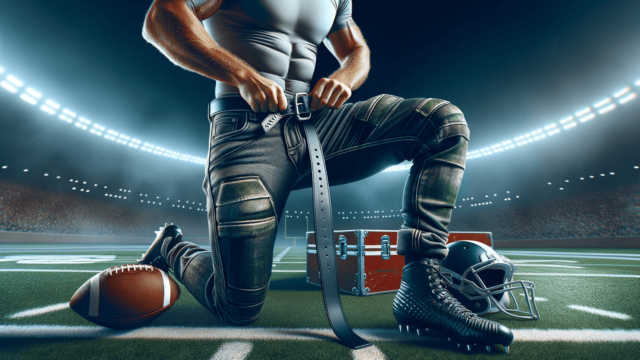
To tie football pants, follow these steps: 1) Wear a football girdle with hip, tailbone, and thigh pads. 2) Put on the game socks. 3) Pull the pants up to the waist, making sure the belt loops align with each other. 4) Put a belt through the loops and buckle it, ensuring the fit is secure but comfortable. 5) Adjust leg elastics and snap buttons on the sides, if available, to ensure a snug fit around the thighs and knees. 6) Tuck in the jersey into the pants.
Steps to Tie Football Pants Properly
Wearing football pants correctly helps to ensure player safety and comfort on the field. Follow the steps below to tie your football pants with ease.
1. Wear a Football Girdle
Begin by wearing a football girdle equipped with essential padding including hip, tailbone, and thigh pads. The anatomically correct placement of these pads will provide vital protection during gameplay.
2. Put on Game Socks
Next, put on your game socks. This will help maintain a proper fit for the pants and ensures your socks won’t bunch up under your uniform.
3. Position Football Pants
Pull the football pants up to your waist, making sure the belt loops are aligned with each other. Slide your fingers along the waistband to ensure an even fit.
4. Insert and Secure Belt
Slide a belt through the belt loops, ensuring it’s fitted properly. Buckle the belt tight enough to secure the pants comfortably without restricting movement.
5. Adjust Leg Elastics and Snap Buttons
If your football pants have leg elastics and snap buttons, adjust them for a snug fit around your thighs and knees. This will allow for better mobility and reduce the risk of pants snagging during play.
6. Tuck in the Jersey
Finally, tuck your jersey into your football pants for a sleek, professional appearance on the field. This will also prevent your jersey from flying up or becoming entangled during gameplay.
Maintaining Football Pants
Keeping your football pants clean and well-maintained is crucial to their durability and performance. After each use, wash them according to the manufacturer’s instructions to prevent long-term damage and wear. Inspect the pants regularly for any rips, loose threads, or damaged padding that may require repair or replacement. Attention to maintenance can extend the lifespan of your football pants, protecting your investment.
Choosing the Right Size
Selecting the correct size for your football pants is crucial for comfort and safety on the field. Refer to the manufacturer’s size chart and measure your waist, hips, and inseam to ensure a proper fit. Your football pants should be snug yet comfortable, allowing for a full range of motion during play. If you’re unsure of your size, consult with a sports apparel professional or a coach for guidance.
Customizing Football Pants
upplement your football pants with additional padding options for enhanced protection and style. Integrated football pants contain built-in hip, tailbone, and thigh pads for a seamless fit and extra security. Alternatively, separate pads can be added to traditional football pants for a more customizable, tailored feel. Explore various material choices, such as hardshell or foam pads, to find the perfect combination of comfort, weight, and protection for your specific needs on the field.
The Importance of Quality Material
The right fabric and construction can significantly impact your performance and comfort on the field. Choosing football pants made from high-quality materials, such as spandex or polyester blends, is essential for durability, breathability, and ease of movement. Look for pants with reinforced seams and stitching, designed to withstand the wear and tear of high-intensity gameplay. Moisture-wicking materials are also beneficial to keep you cool and dry during games, reducing chafing and discomfort.
FAQ Section: Tying Football Pants and More
Find answers to frequently asked questions about tying football pants and related topics to ensure that you’re well-prepared for gameplay and can maintain your football gear appropriately.
What type of belt should I use for my football pants?
Use a durable, adjustable belt for your football pants, preferably made from a sturdy material like nylon or polyester webbing. Ensure that the belt matches your waist size and fastens securely without hindering movement.
Can I wear my regular athletic socks with the football pants?
It’s best to wear socks specifically designed for football, which often have cushioning, arch support, and moisture-wicking properties. Football socks are generally knee-high to keep shin guards in place and provide additional leg protection.
How do I know if my football pants are too tight or too loose?
If your football pants restrict movement or cause discomfort, they might be too tight. Conversely, if they sag or require constant readjusting during play, they are likely too loose. Your football pants should fit comfortably snug, allowing for a full range of motion without compromising on protection.
What can I do if my football pants don’t have belt loops?
If your football pants do not have belt loops, they might have an integrated elastic waistband designed to ensure a snug fit. Make sure that the waistband is secure and comfortable, and if necessary, consider adding compression shorts or a girdle with an adjustable drawstring for additional support.
How often should I replace my football pants?
The lifespan of football pants varies depending on factors such as frequency of use, maintenance, and quality of materials. Regularly inspect your pants for signs of wear or damage, and replace them when they no longer provide adequate protection or support. Proper care and maintenance can greatly extend the longevity of your football pants.
Featured Posts
- No pillar pages found.





